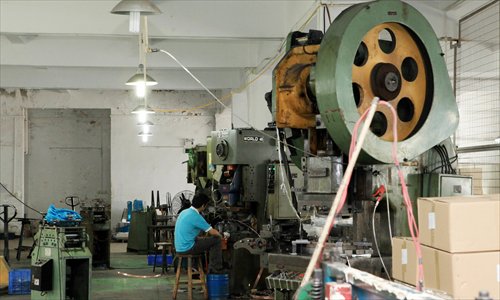HOME >> CHINA
Robots attack labor shortage
Source:Global Times Published: 2015-5-5 20:58:01
Guangdong factories respond to lack of workers with mass automation

A worker fixes a machine in a metal factory in Dongguan, Guangdong Province, in March 2015. The factory planned to introduce more machines and robots to reduce the number of workers. Photo: CFP
An array of mechanical arms and complex machines are poised to replace the human assembly line workers at the Everwin Precision Technology Co., which will become the first factory in Guangdong Province to become fully automated under a new "replace human workers with robot workers" policy, China Youth Daily reported.
The automation of the factory, located in Dongguan, represents what may be a significant new trend - the rise of the robot in the Chinese labor force to offset increasing labor costs.
Fully robotic
Everwin Precision Technology Co has purchased 1,000 new robots, joining 100 that were already working on the assembly line.
This will reduce the number of workers the factory needs, protecting it from a labor shortage which many cities in Guangdong are facing.
"A robotic production line does not mean there is no human labor at all, but it will reduce by about 90 percent the number of the workers," said Chen Qixing, the chairman of the company.
"After the factory is fully equipped, it still needs about 200 staff to control the network, and serve as management, while in the past, we needed more than 2,000 workers to operate the entire factory," he explained.
Ren Xiangsheng, a deputy general manager of the company, told China Youth Daily that replacing human labor with robots will also enhance product safety and quality.
"Dongguan is currently working very hard to promote 'replace human workers with robot workers' and our company is determined to become an intelligent robotic factory, using mechanical arms to replace human labor, and build a highly intelligent control system which is run via a network," he said.
"This will greatly improve work efficiency and quality," Ren added.
Subsidized scheme
The governments of cities in the Pearl River Delta such as Dongguan and Foshan launched the "replace human workers with robot workers" scheme in 2014, after seeing its labor shortages create unrest.
According to China News Service, Guangdong Province suffers a shortfall of nearly 800,000 laborers this year, while Dongguan is lacking 100,000 laborers.
In order to encourage the development of robotic production lines, the cities are handing out between 200 million yuan ($32 million) and 500 million yuan in annual subsidies to robot producers and manufacturers who install robots on assembly lines between 2014 and 2016.
As a result, large numbers of robots have already been installed on production lines throughout the province, Guangdong Deputy Governor Xu Shaohua said.
The Dongguan Economy and Information Bureau said that to date, the city has invested more than 4.2 billion yuan on the robotics scheme.
As the technology for automatic production improves, enterprises in these cities are also becoming more innovative.
Zheng Weiping, an assistant manager of the office of the president of CWB Group, a vehicle electronic company, told people.cn that robots have greatly improved the company's efficiency, because one robot can do the work in a day equivalent to six laborers working continuously for a week.
"Apart from low efficiency, workers were always injured by the machines," he said.
Labor shortage solution
The rise of the robots could resolve the labor shortage that is affecting not only Guangdong but also other provinces in the country. Robots give enterprises options to stay competitive other than increasing wages or benefits.
Guangdong authorities plan to invest 943 billion yuan to replace human laborers with robots within three years, according to Xinhua.
Zhai Suoling, the president of the Dongguan Taiwan-funded Enterprises Association, said that automating a factory requires a massive investment upfront, but some enterprises can recover the cost in a few years, askci.com reported.
"Compared to the cost of labor, which is increasing more than 20 percent a year, investment in robots may be more worthwhile," he said.
The Dongguan Economic and Information Bureau said the scheme has successfully helped the city reduce its labor shortage by about 30,000 people since 2014.
The rise of the robotic factory, however, has also drawn concern. A Xinhua report published on May 4 said replacing human labor with robots will make it more difficult for job seekers to find work, particularly those who are not well educated, because the minimum standard for laborers will increase.
"Those workers who are knowledgeable and have technical skills will be very welcomed by enterprises because they can do maintenance work for the robots and machines," it wrote. "Enterprises and workers both need to change to survive."
The momentum toward automated factories is continuing. The city of Guangzhou has set a goal of fostering robotic factories with an output value of more than 100 billion yuan and automating more than 80 percent of the city's manufacturing production by 2020, according to the South China Morning Post. The Guangdong provincial government announced in March that it will spend 943 billion yuan on replacing human labor with robots over the next three years.
Posted in: Society